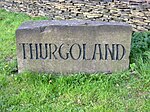Oxspring

Oxspring is a village and civil parish in the Metropolitan Borough of Barnsley in South Yorkshire, England. At the 2001 census it had a population of 1,048, increasing to 1,225 at the 2011 Census. The civil parish includes the hamlets of Clays-Green, Roughbirchworth and Storrs. It is situated on the River Don with the main village being between the Sheffield Road (B6462) and the route of the Trans Pennine Trail. On the other (NE) side of the river is the A629, part of which is called Oxspring Lane, indicating the position of the original hamlet (now High Oxspring Farm). The parish has a post office, a combined C of E church and community hall, St Aidan's, a primary school and three public houses, the Waggon and Horses on the B6462, The Smithy Arms on Bower Hill and the Travellers Inn on the A629. There is a small amount of industry at the north west end.
Excerpt from the Wikipedia article Oxspring (License: CC BY-SA 3.0, Authors, Images).Oxspring
Mayfield,
Geographical coordinates (GPS) Address Nearby Places Show on map
Geographical coordinates (GPS)
| Latitude | Longitude |
|---|---|
| N 53.514 ° | E -1.594 ° |
Address
Mayfield 3B
S36 8YN
England, United Kingdom
Open on Google Maps







